From Wikipedia: “Threshing is the process of loosening the edible part of cereal grain (or other crop) from the scaly, inedible chaff that surrounds it. It is the step in grain preparation after harvesting and before winnowing, which separates the loosened chaff from the grain.” You can’t winnow the wheat from the chaff based on just one episode, or you risk missing out on shows like Tatami Galaxy and Shiki. But you can at least get some idea. Below are some ideas, sorted in increasing order of how much potential the show seems to have based on the first episode. (Translations of show titles are my own amateur efforts and may be wildly inaccurate.)
15: Kitakubu Katsudou Kiroku (Log of the Activities of the Go Home Club)


Five girls in a club for having fun. This might be the worst “club about nothing” show I’ve ever seen. The “comedy” writing slavishly followed the Japanese “boke-tsukomi” template, which is basically where one character says something stupid and then another character yells “that’s stupid!”. It can work as a skeleton for comedy, if you dress it up cleverly and subtly, but there was no subtlety here. Every third line or so was the protagonist shouting about how the implausible scenario outlined in the previous two lines was implausible. Even if I wanted to laugh at some comical absurdity the show presented, I would be interrupted by her shouting about how absurd it was before I could properly collect my mirth. Used like this, the “tsukomi” is basically the Japanese version of Big Bang Theory’s laughtrack, covering up for really bad jokes and killing the slightly less bad ones. The animation wasn’t very pleasant to look at either. They were cracking jokes about their low budget, but the show looked bad enough that they were just kicking themselves while they were down. Would have been better not to draw attention to it. Go home, Go Home Club.
14: Genei wo Kakeru Taiyou (The Sun That Pierces Illusions)


A girl who tells the future with Tarot cards is attacked by horrifying monsters. At the end of episode one, I have no idea what’s going on in this show, and I haven’t been introduced to any real characters except the main girl, who is an utterly standard happy friendly girl who tries her best. The fight scenes against the monsters had nothing interesting going on in them, just the girl getting strangled until it was time for magic to magically save her. The show does seem willing to go dark, but going dark isn’t enough if you don’t have interesting characters or an interesting plot or interesting fight scenes or interesting commentary on political philosophy or even decent character designs. There’s an outside chance that this could turn out to be the next Higurashi, but if it is I’ll have to rely on someone else to tell me.
13: Makai Ouji: Devils and Realist (Prince of Hell: Devils and Realist)
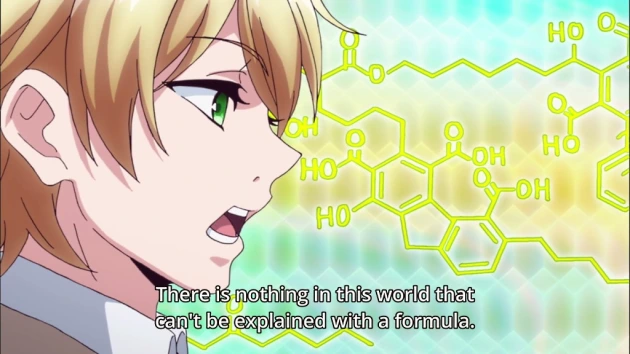

A young materialist noble discovers he is the Heir of Solomon and is dragged into a battle among the devils of Hell. The best thing I can say about this show is that there’s nothing really offensively bad about it. The jokes about how the protagonist doesn’t believe in the supernatural are obvious and unfunny, but they aren’t painful. The characters aren’t unlikable, they’re just uninteresting. The character designs are standard pretty-boy bishounen with various hair colors, but they’re not ugly. The fight scenes were undistinguished magical laser tag, but they were short enough I didn’t have time to get bored with the flashing lights. I’m not remotely interested in the “Hell politics to replace Lucifer” plotline they were setting up, but I could probably manage to listen politely while a fan of the show described it to me. (Or at least as politely as I do anything.) There’s nothing I like about Makai Ouji, but I feel absolutely no urge to track down the show’s creators and exact revenge for what they put me through, and some days that’s all I can ask.
12: Inu to Hasami wo Tsukaiyou (Let’s Use a Dog and Scissors)

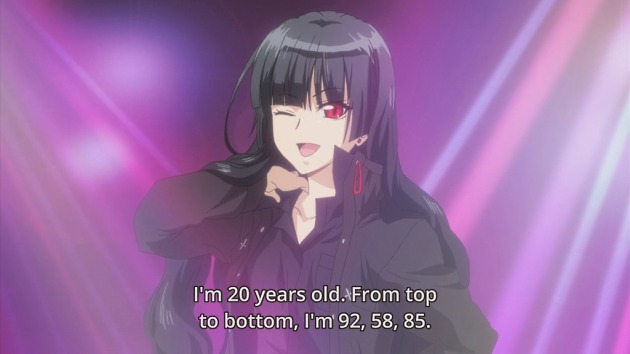
An avid reader is killed and comes back to life as a dog and is adopted by his favorite author who can hear his thoughts. There is too much going on in the premise of this show, and none of it’s related to anything else. The male lead is crazily obsessed with books AND he gets murdered and comes back to life AND he’s a human in a dog’s body. The female lead is a wealthy authoress AND she can read the male lead’s mind AND she behaves violently with scissors on little-to-no provocation. A good premise for a story has one or two unusual background facts that the story can develop out of while remaining otherwise relatively grounded. Dog Scissors has six mutually independent unusual facts. It’s a mess. And it leaves the characters nothing but caricatures. Leaving the premise aside, the art’s not bad but the comedic writing is fairly weak. There were a few jokes I smiled at, but far too many “jokes” were just the female lead being violent toward the male lead for no reason and the male lead reacting with fear, or else the male lead commenting on the female lead’s smallish breasts and the female lead reacting with anger. They went out of their way to put the female lead in a position where her breasts would be exposed just so the male lead could comment on them and make her angry, so that they could make the same lame joke over and over. As for the plot, it might be interesting to watch him try to track down his killer as a dog, but I sort of doubt any sort of mystery plot springing from a premise this nutso can turn out well.
11: Danganronpa Kibou no Gakuen to Zetsubou no Koukousei (Shotgun Argument Academy of Hope and Students of Despair)

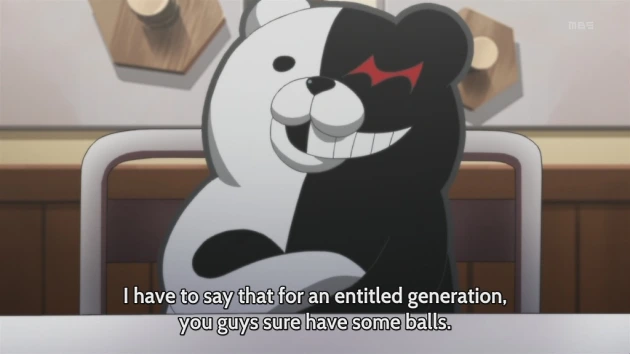
Fifteen talented youths are imprisoned in a high-school and must kill each other if they wish to leave. This is no Mirai Nikki. The whole thing just seemed empty to me, artificial. The stupid bear thing that’s leading the survival game doesn’t make for a compelling villain, because it seems to have no motive or purpose other than to be a dick. (The “cute but evil” aesthetic is pretty played out anyway.) The survival game participants are all flat one-note characters who have bizarre character designs but utterly conventional personalities. And the rules of the survival game itself are too simple to be interesting. Maybe they just did a bad job of pacing the introduction, maybe the characters and rules will get more fleshed out later – but even so, if they blew the pacing this badly in the first episode, it doesn’t bode well for the rest of the series. My understanding is that this is to be a single-season show, and even with twice as many episodes and 20% fewer survival game participants to kill, Mirai Nikki often ended up feeling rushed. Maybe it would be better to play the original VN instead.
10: Fate Kaleid Liner Prisma Ilya

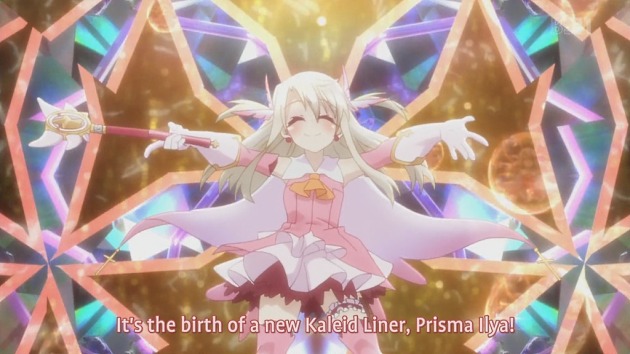
A Fate/Stay Night imaginary story where Rin and Ilya are recast as magical girls. This is no Rosencrantz and Guildenstern Are Dead. Seems like it’s going to be an “affectionate parody” of the magical girl genre, which means it’s basically a magical girl show that doesn’t want to take responsibility for being a magical girl show. And it’s focused on Ilya, who was never my favorite F/SN character and in this incarnation has been stripped of the yandere tendencies that were the only interesting thing about her. (She’s also been stripped of her clothes for longer than seems strictly necessary for legitimate storytelling purposes.) Tohsaka Rin is there as a secondary character, and she’s amazing of course, but the new characters, the magic wands and the curly-haired blonde girl, they have nothing going for them either. No matter how fondly I recall the Unlimited Blade Works route, Rin isn’t enough to get me to watch a show that’s otherwise this bad.
9: Kiniro Mosaic (Golden Mosaic)
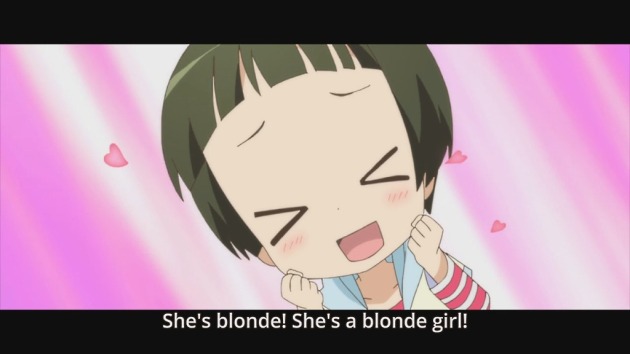

A British highschool girl (blonde) comes to live in Japan. I can’t say I thought much of the first part of this episode. It went way too heavy on the sugary-sweet little girls becoming ~*best friends*~. I knew going in that this would be a cutesy show, but I was insufficiently prepared and the “Hello!” “Konnichiwa!” scene left me gagging. It didn’t help that the supposed British natives spoke their English with a thick Japanese accent. The main British girl, Alice, is probably going to be speaking most of her lines in Japanese from now on, so I will grudging accept casting a native Japanese speaker in that role. But at least they should have gotten a Brit to play her mother! That said, once we left the flashback in Britain and returned to present-day Japan, things started looking better. There were jokes, there were more than two characters, there was even the barest hint of some friendly conflict. Unfortunately that was only the last few minutes of the episode, so it’s hard to judge the quality of the show going forward.
8: The World God Only Knows Goddesses Chapter

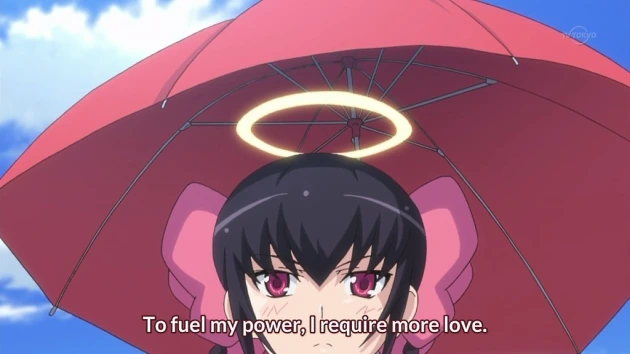
Season three of TWGOK. I really want to give TWGOK the benefit of the doubt here, because we’ve had some good times together, but there wasn’t much to like in this episode at all. TWGOK’s premise is a really great one, it lets you string a bunch of romances together and still give them all satisfying conclusions. So why are they throwing that all away to give us some joke of a supernatural plot involving a war between heaven and hell? What I want out of TWGOK is primarily jokes and secondarily romance. If they’re going to be transitioning to supernatural combat instead, that’s a different show from the first two seasons, and it’s not a show in a genre I like very much.
7: Servant x Service
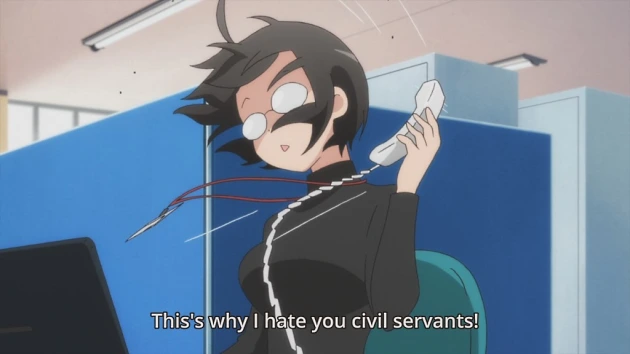
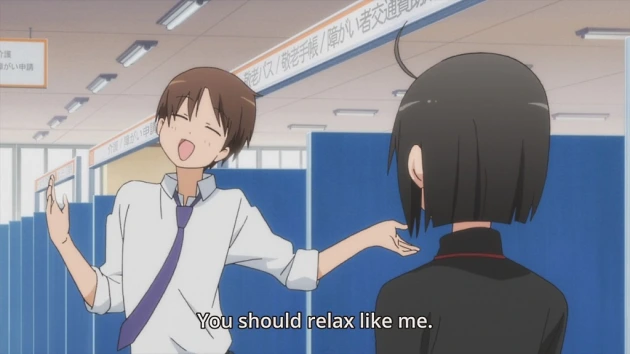
Three newly-hired civil servants deal with the realities of working in the bureaucracy. This was a pleasant episode. All three main characters are interesting and likable, and the setting is fresh. I feel like for a comedy it really isn’t very funny, though. Some of the slacker dude’s antics were appropriately comic, but a lot of the time it just seemed like an infomercial for the Japanese bureaucracy. If they’re going to have a moral at the end of every episode where they hug and learn the importance of properly filling out paperwork I’m out. The animation is no great shakes either, although the character designs feature young women in business suits and I at least approve of that.
6: Blood Lad
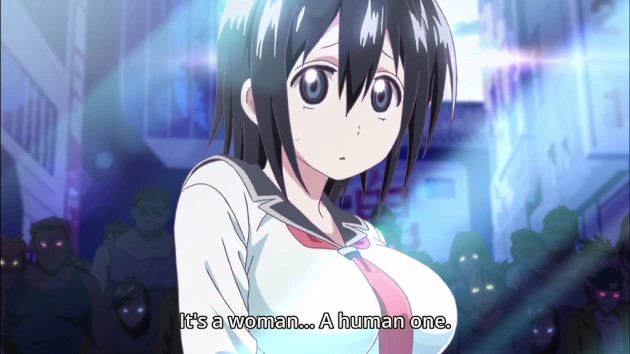

A schoolgirl ends up in the Demon World and is killed, but a powerful vampire who is obsessed with Japanese pop culture promises to bring her back to life. I’m impressed with the quality of the pop culture references dropped in this show. Far too often writers think it’s funny just to mention a thing from pop culture (I’m looking at you, Hayate no Gotoku), but Blood Lad actually makes jokes from them. Unfortunately there were also quite a few jokes in this episode of the form “look at how wacky the Demon World is, isn’t the Demon World wacky?” but apparently the characters are headed to the real world next episode so hopefully that should all shake out. And the male and female leads are both likable. Well, the male lead is likable and the female lead has large breasts, which is the next best thing, right?
5: Kamisama no Inai Nichiyoubi (Sunday Without God)

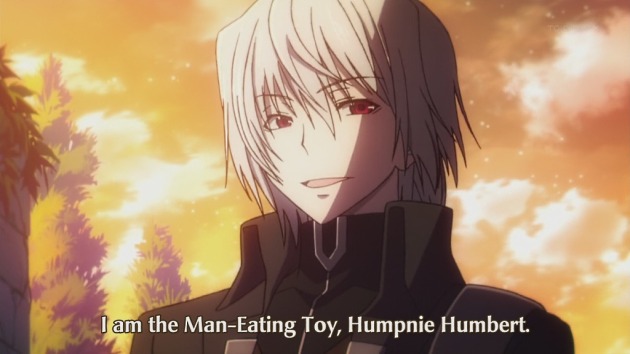
In a world where people don’t die when they are killed, only special “gravekeepers” can lay the dead to rest. A 12-year-old girl follows in her mother’s footsteps as gravekeeper, unless maybe she doesn’t, it’s not entirely clear. There were a lot of problems with this first episode. The mysteries of the gravekeepers, for example, were not really clarified. They spent the first half of the episode telling us how everything worked and then in the second half a silverhaired gunslinger shows up and says “no, that’s all wrong lol”. Then there was the jarring tone-shift from childishly cute banter to Humbert’s mass what-would-be-murder-if-people-could-die. And the art is nothing special, the backgrounds are orange and the character designs are generic. But even so, I find myself drawn to continue watching No God Sunday. I don’t usually get taken in by anime that introduce “mysteries”, but I find myself actually wanting to know what the deal is with Ai’s past. She’s generic, but somehow she’s likable. She’s suffered a great tragedy and had her whole identity torn to pieces by a mysterious stranger, and I want to know what happens next. That’s what it comes down to.
4: Tokurei Sochi Dantai Stella Jo-Gakuin Koutou-ka C3-bu (Special Programs Organization Stella Women’s Academy Special Course C3 Club)


A shy girl enters highschool and joins the Airsoft Gunsport Club “C3-bu”. This could turn out pretty well! Swords are better than guns, but guns are still pretty good, and even the introductory battle they had in this episode was fairly interesting. Presumably once we’re all familiar with the premise they’ll bring out harder-core survival game triple-bluffs. As I feared, the girls don’t actually look all that great in miniskirts – the school uniform designs for Stella Jogakuin are boring and the skirts are plain grey pleated nonsense. The safety goggles look great though. They’re all different colors and they make the girls look like a badass superhero team. I remember Mouretsu Pirates had a scene with a schoolgirl with safety goggles and a gun too, and that stuck in my memory despite the general forgetability of the series. We haven’t seen enough of the girls’ personalities off the battlefield to judge them accurately, but what we’ve seen looks good. I especially like the blond-haired girl and the long brown-haired girl, who are both sort of unhinged over airsoft gunsport but in totally different directions. And at the end of the day, I find “cute girls doing cute things” shows more palatable when the cute things are things like cutely handling a replica machine gun.
3: Love Lab

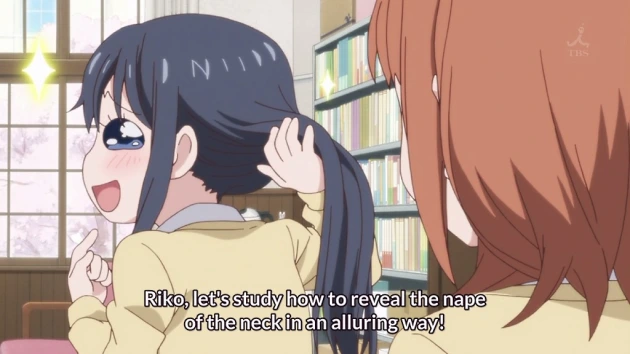
An inexperienced middle-school girl is taught the ways of love by an equally-inexperienced middle-school girl. To begin with I wasn’t even going to watch this because it sounded like a schoolgirl lesbians show in the vein of Yuru Yuri, but it got hyped online so I picked it up and I’m glad I did. Love Lab reminds me more of B Gata H Kei than Yuru Yuri, with a stylish girl faking romantic experience and lots of jokes at the expense of people trying to pretend they know it all. I felt like I should have liked B Gata H Kei, but the pacing was off or the jokes weren’t funny enough or something just wasn’t right. I think Love Lab can do better, because Maki and Riko can play off each other for comedy, rather than Yamada having to carry the show on her own by talking to herself. And if we’re really lucky, no boys will show up and ruin our romantic-inexperience comedy by injecting actual romantic experience. Then again, what sort of Love Lab is it if you don’t do any experiments that could cause explosions?
2: Watashi ga Motenai no wa Dou Kangaite mo Omaera ga Warui (Why Don’t You Fuckers Love Me)


An isolated high school girl tries to improve her social position but has a myriad of personal failings. Generally speaking, I’m not a fan of “cringe” comedy, or awkward comedy. When fictional characters are put in situations where they lose dignity due to their farcical fumblings, I don’t laugh, I just feel bad for them. And Watamote is certainly a member of that genre; the female lead’s fumblings toward popularity could hardly be more farcical. But I’m laughing. My grin started about the time Tomoko started playing boy-touching games on her DS and really never left. I think the issue might be that I see the parts of myself I like least in Tomoko. Usually I don’t feel good about laughing at awkward comedy because “nobody deserves to feel that uncomfortable”, but there’s an implicit “(except me of course)” in there. Tomoko has an unjustified feeling of superiority and scorn towards others, a sense of entitlement that carries through even to the title of the show, and an instinctive response to flinch away from harsh reality. Those particular vices, I know what they feel like from the inside, and so I’m not inclined to forgive them. I know they’re unjustifiable, or I’d be able to justify them in myself. And so I’m happy to see her taken down a few pegs in a cathartic ritual to exorcise my own demons. Uh, anyway, my personal issues aside the show is pretty darn good? The animation quality is nothing super special but it’s got some creative direction choices going on, and the voice actress for Tomoko is doing a great job in the role. The jokes are funny if you’re a loser nerd and hate yourself and hey, who isn’t and doesn’t?
1: Monogatari Series Second Season


Apparently the second season of the Monogatari series? I guess Nisemonogatari was just a wet dream. New protagonist, same batshit Shaft style. I was a little skeptical about how well Monogatari starring Hanekawa was going to go given that she was more or less the boringest character in Bakemonogatari and Araragi is my role model, but seeing the world through her eyes really improved my opinion of her. Her problem as a character is that her martyr complex leads to her bottling her concerns inside herself, so you never find out the interesting things about her unless you get a look at her inner monologue. It was also interesting seeing a different side of Senjougahara, although it was a surprisingly similar side of Senjougahara actually, right down to the talking about weighty issues while showing off her naked body. Mayoi, on the other hand, turns out to be super boring without Araragi around to molest her, but I think we’ve seen the last of her for this arc so no worries. Yeah, Shaft is still great, Senjougahara is still great, Monogatari series is still great, A+ #1.
All told, that’s an amazing yield for a summer season. Two shows that look like they’re pretty much guaranteed to go great, and five more that seem worth hoping for. And then there’s TWGOK, which I have only despair for, but which deserves at least a couple more episodes before I drop it. It’s a pity though that there doesn’t seem much worth watching that’s straight action or drama or anything. Comedy is great and I love it, but I’m not sure I want six of my seven shows to be just about making jokes all the time.





























